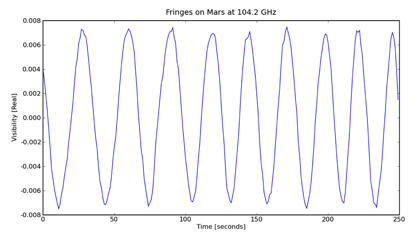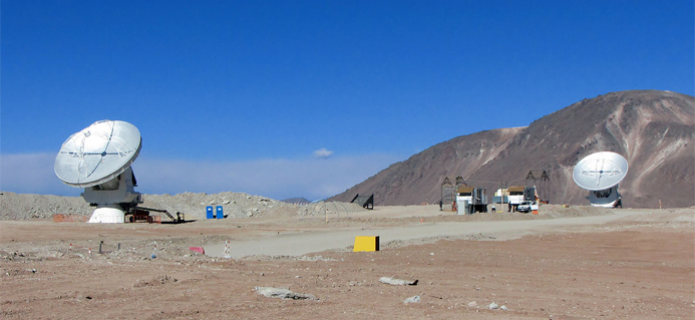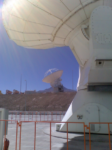ALMA Telescope passes major milestone with successful antenna link
6 May, 2009 / Read time: 5 minutes
The Atacama Large Millimeter/submillimeter Array (ALMA), an immense international telescope project under construction in northern Chile, reached a major milestone on April 30, when two ALMA antennas were linked together as an integrated system to observe an astronomical object for the first time.
The milestone achievement, technically termed "First Fringes," came at ALMA’s Operations Support Facility, 2900 meter above sea level.
"This is another important step forward for ALMA as it proves that the various hardware components can work well together. The efforts of all the staff involved in this first antenna integration show the strength of our global collaboration and give much confidence that we can get to full operations with ALMA as one great astronomical observatory," says Thijs de Graauw, ALMA Director.
Faint radio waves emitted by the planet Mars were collected by the two 12-metre diameter ALMA antennas, then processed by state-of-the-art electronics to turn the two antennas into a single, high-resolution telescope system, called an interferometer.
Such pairs of antennas are the basic building blocks of imaging systems that enable radio telescopes to deliver pictures that approach or even exceed the resolving power of visible light telescopes. In such a system, each antenna is combined electronically with every other antenna to form a multitude of antenna pairs. Each pair contributes unique information that is used to build a highly-detailed image of the astronomical object under observation.

The two ALMA antennas pointing at Mars. Image courtesy of Lewis Knee (ALMA)
When completed in early in the next decade, ALMA’s 66 antennas will provide over a thousand such antenna pairings, with distances between antennas exceeding sixteen kilometres. This will enable ALMA to see with a sharpness surpassing that of the best space telescopes. The antennas will operate at an altitude of 5000 metres, high above the OSF, in one of the best locations on Earth for millimetre-wavelength astronomy, the Chajnantor Plateau in Chile’s Atacama Desert.
Last week’s successful Mars observation was conducted at an observing frequency of 104.2 GHz. Astronomers measured the distinctive varying “fringes” detected by the interferometer as the planet moved across the sky.
"This can only be achieved with the perfect synchronisation of the antennas and the electronic equipment: a precision much better than one millionth of a millionth of a second between equipment located many kilometres apart. The extreme environment where the ALMA observatory is located, with its strong winds, high altitude, and wide range of temperatures, just adds to the complexity of the observatory and to the fascinating engineering challenges we face", comments Richard Murowinski, ALMA Project Engineer.
ALMA will provide astronomers with the world's most advanced tool for exploring the Universe at millimetre and submillimetre wavelengths. It will detect fainter objects and be able to produce much higher-quality images at these wavelengths than any previous telescope system. Scientists are eager to use this transformational capability to study stars and galaxies that formed in the early Universe, to learn long-sought details about how stars are born, and to trace the motion of gas and dust as it whirls toward the surface of newly-formed stars and planets.
“We are on target to do the first interferometry tests at the 5000-metre high-altitude site by the end of this year, and by the end of 2011 we plan to have at least 16 antennas working together as a single giant telescope,” says Thijs de Graauw.
The ALMA Project is a partnership between the scientific communities of East Asia, Europe and North America with Chile.
Images
• This graph shows a plot of a single channel of the correlator output as a function of time, when observing Mars.

• In the next image, we see a screenshot of the full correlator output for a single one-second integration. The top two windows are the spectral shapes of the signals from the two individual antennas. The bottom ones are the phase (right) and cross-correlated power (left), which is a little less than one percent of the total.

• The two ALMA antennas used in the project's successful test observation of "first astronomical fringes", at the Operations Support Facility at an altitude of 2900 metres. Credit: ALMA (ESO/NAOJ/NRAO)
Notes for editors
The Atacama Large Millimeter/submillimeter Array (ALMA), an international astronomy facility, is a partnership of the European Organisation for Astronomical Research in the Southern Hemisphere (ESO), the U.S. National Science Foundation (NSF) and the National Institutes of Natural Sciences (NINS) of Japan in cooperation with the Republic of Chile. ALMA is funded by ESO on behalf of its Member States, by NSF in cooperation with the National Research Council of Canada (NRC) and the Ministry of Science and Technology (MOST) in Taiwan and by NINS in cooperation with the Academia Sinica (AS) in Taiwan and the Korea Astronomy and Space Science Institute (KASI).
ALMA construction and operations are led by ESO on behalf of its Member States; by the National Radio Astronomy Observatory (NRAO), managed by Associated Universities, Inc. (AUI), on behalf of North America; and by the National Astronomical Observatory of Japan (NAOJ) on behalf of East Asia. The Joint ALMA Observatory (JAO) provides the unified leadership and management of the construction, commissioning and operation of ALMA.
ALMA will operate at wavelengths of 0.3 to 9.6 mm. At these wavelengths, a high, dry site is needed for the telescope to be able to see through the Earth's atmosphere. This is why ALMA is being built on the breathtaking 5000-metre-high plateau of Chajnantor in the Atacama region of Chile, the highest astronomy site in the world. ALMA will offer unprecedented sensitivity and resolution. The 12-metre antennas will have reconfigurable baselines ranging from 15 m to 16 km. ALMA will have a resolution ten times better than the Hubble Space Telescope.



